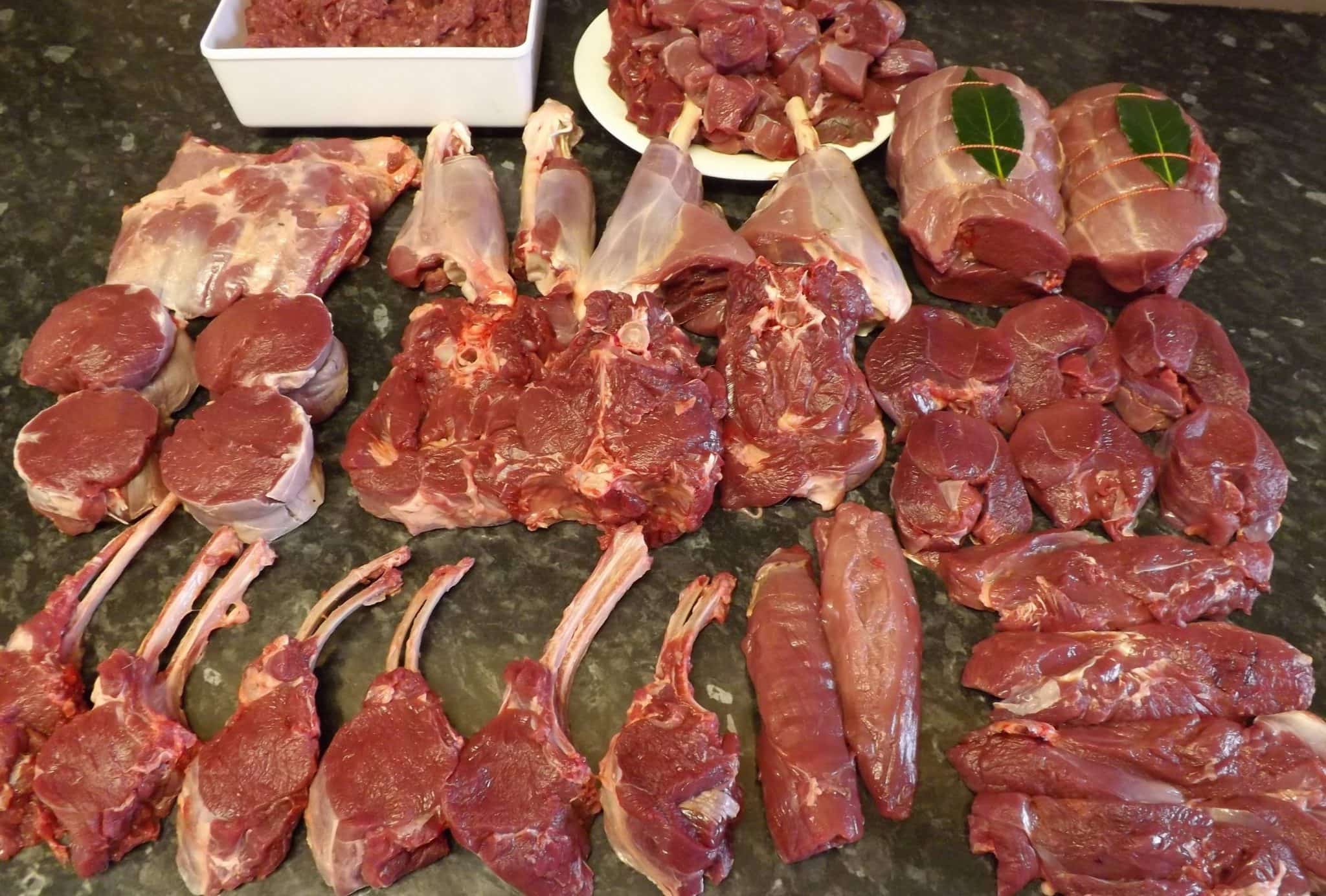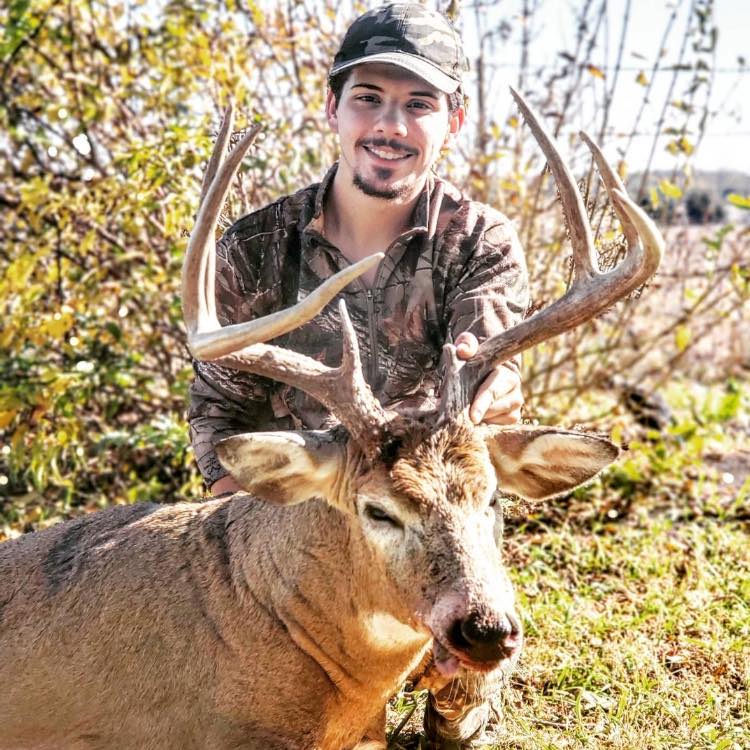Most deer take place some distance away from home. Many hunters process deer in the field and wish to grind their own deer meat. Other hunters take deer to the butcher and collect venison later. Meanwhile, they are left wondering if they would detect it should the butcher cheat them off a few pounds. So, can they? To answer the question above, we must ask ourselves, “ How much meat is from a deer ?” To get this answer we made a custom deer meat yield calculator where you can find how much edible meat you will get before and after the field dress and the level of butchering.
Deer Meat Yield Calculator: How Much Meat From A Deer You Can Get:
The estimated yield of edible meat is:
How Much Meat Is On A Deer
Many hunters have asked me for a formula to calculate how much meat is on a deer to expect from the butcher. 40-50% of live weight rightly sums up how much venison from a deer you get. A more precise formula is, however, needed to reduce the error margin.

Before the formula, here are a few definitions to keep in mind.
- Live weight: Total weight of a deer.
- Field-dressed Weight: Weight of the deer carcass without the innards.
- Hanging Weight: Weight of a field-dressed deer without the skin, head, and inedible leg portions.
Now, for the formula:
Edible meat = Live-Weight x 0.408 ( This is the MOST accurate estimate in my experience – *If the butcher is experienced*)
How did I arrive at this calculation? Let me walk you through my reasoning. Things may get a little complicated; I suggest you take me at my word. If, however, you need elaboration, read on.
- First, determine the live weight of the deer. This is the weight of the deer before it has been field-dressed (gutted and cleaned).
- Next, calculate the field-dressed weight of the deer using the following formula: Field-dressed weight = Live weight x 78%
- Then, calculate the hanging weight of the deer using the following formula: Hanging weight = Field-dressed weight x 75%
- Next, determine the butcher experience level (Experienced, Advanced, Intermediate, or Beginner).
- Finally, calculate the yield of edible meat using the following formula: Edible meat = (Hanging weight x 75% ) * Butcher experience level value
- Where the Butcher experience level value is: Experienced Butcher = 0.93 Advanced Butcher = 0.90 Intermediate Butcher = 0.86 Beginner Butcher = 0.80
So, for example, if the live weight of the deer is 200 pounds, and the butcher is an experienced one, the yield of edible meat would be:
- Field-dressed weight = 200 pounds * 78% = 156 pounds
- Hanging weight = 156 pounds * 75% = 117 pounds
- Edible meat = (117 pounds * 0.75) * 0.93 = 81.61 pounds
It’s important to note that there are many factors that can affect the yield of edible meat from a deer, including the deer’s age, sex, and overall condition, as well as the skill level of the butcher. These formulas provide an estimate and should be considered as such.
Real Example: For example, let us look at the meat on a 78 Kg buck (after Field Dress):
Lets say The Field-dressed deer weight approximately 78Kg
Field-dressed Weight= 78Kg
Hanging Weight= Field-Dressed Weight x 75% (NB.: 75%= 0.75) = 78 Kg x 0.75 = 58.5 Kg
Edible Meat= Hanging Weight x 75% (NB.: 75%= 0.75) = 58.5 x 0.75 x 0.93= 40.80 Kg
A 78 Kg deer will, therefore, give 40.80 Kg of edible meat.
How Does Butcher Experience Affect Deer Meat Yield?
The skill level of the butcher can greatly affect the yield of edible meat from a deer. A more experienced and skilled butcher will be able to remove more of the bones, fat, and other inedible parts of the deer, resulting in a higher yield of edible meat.
A beginner butcher may not be as proficient in removing these inedible parts, resulting in a lower yield of edible meat. Additionally, an experienced butcher is likely to be more efficient in breaking down the deer, which can result in less waste and higher yields.
Additionally, the butcher’s experience level can also affect the quality of the meat. An experienced butcher will be more likely to properly handle and process the meat, which can result in better flavor and texture.
In summary, the butcher’s experience level can greatly affect the yield of edible meat from a deer, with more experienced butchers typically resulting in a higher yield and better quality meat.
For those who love shortcuts, like yours truly, check it out below:
| Beginner Butcher | .351 |
| Intermediate Butcher | .377 |
| Advanced Butcher | .395 |
| Experienced Butcher | 0.408 |
Edible Meat= Live-Weight x 0.408 = 100 Kg x 0.408= 40.8 Kg
I seek to put the myths to rest. So, how much meat do you get from a deer? Well, as I said earlier, deer will yield venison 40% to just under 50% of its weight. Yield will range from deer to deer but always in the 40-50 percentile.
The formulas are only estimations. Yield varies from deer to deer. Other factors determine how much meat is on a deer. Let us look at a few.
How Much Meat Does A Deer Yield And Why?
The main factors that determine deer meat yield are:
- Size Of The Deer
- Skill Of The Hunter/ Butcher
- State Of The Deer
Size Of The Deer
It is obvious that you may asked me, “How many pounds of meat from a deer?” The answer to this question is heavily determined by the size of the deer. Sex determines how big a deer will grow. The average mature Buck weighs about 160 lbs. A mature Doe, on the other hand, weighs about 140 pounds. Bucks, therefore, give more meat than Does.
Some think that Does should yield more because they have a less:
- Bone-to-live-weight ratios
- Blood-to-live-weight ratios
The proportions are accurate, but the assertion above is false. The claim fails to take one more fact into consideration. The ratios for the Doe are insufficient to offset Buck’s almost 20 Plus Pound advantage.
Sex also determines the quality of venison. Bucks tend to be more masculine than does. Their meat is, therefore, tougher.
In conclusion, Does give more Venison per live weight, but the Buck steals the show on overall yield.
Age also determines deer size. Fawns weigh less than adults. Aged deer also weigh less than young mature ones. The last age bracket produces the most venison of the ages mentioned.
Skill Of The Hunter/ Butcher

How much meat on a deer is affected by the hunter’s skills will shock you. A hunter can lead to the loss of over 10 lbs of venison. A further 5 lbs can be lost when butchering. How does this happen?
The two events in which skill can mess with meat yield are:
- When Shooting Deer.
- When Dressing Deer.
A poorly placed shot destroys meat portions. A shot on the hind leg with a gun can result in the loss of as much as 6 lbs of venison. The best places to shoot deer and not spoil meat portions are
- The Head: Only experienced hunters should take these shots. They are not easy to execute.
- The Neck: A neck shock will cause the deer to bleed to death quickly.
- The Heart Region: The heart region is an excellent place to shoot a deer. The shot is best taken from the side, 4 inches above the fore-leg should do it.
Dressing deer is another skill that can drop yields if poorly executed. Dressing deer is the initial butchering that removes a better part of the inedible. Here the deer is skinned and its innards removed. The head and the inedible portions of the legs follow suit. During the process, two things may lead to the loss of venison yield.
Cutting into the meat while skinning
Skinning is a delicate affair. Take care not to curve into the venison while skinning.
Ruptured Gall Bladder
Ever heard of the saying, “ As bitter as bile?” No kidding! Bile is bitter. It is stored in the gall bladder. The gall bladder is the ‘bluish’ wobble on the liver. When ruptured, it empties the bile within. Bile makes meat to taste awful.
The unpalatable taste usually necessitates discarding the said meat portions.
State Of The Deer
The state of the deer also determines how much venison from a deer reaches your plate. A nursing Doe, for example, will yield less meat per live weight compared to a similar-sized Doe that is not nursing a fawn. The reason is a little bit technical.
Nursing Does need to store food to sustain milk production. The food is stored in the form of fat. Nursing Does, therefore, have very high-fat contents. Unlike domesticated meat, however, fat from deer tastes bad. You have to get rid of it. Nursing Does will, therefore, yield less venison than their ‘free’ counterparts.
Bucks also have lower fat content immediately after the mating season. Most of the fat is burned to sustain the energy for mating and fighting opponents. In this state, they yield more venison per live weight than at any other time.
The three factors affect meat yield across all deer species. Whitetail deer meat is especially loved. The popularity leads hunters to wonder, “How much meat from a whitetail deer goes to waste every day?”
Whitetail is a small deer species. The damage of misplaced shots is, therefore, more pronounced on the species. A bullet lodged in whitetails, lean, hind-leg can destroy as much as 48% of the meat therein. I advise that you be especially careful with shot placement when hunting whitetail for venison. To achieve the best accurate shot, aiming is vital for that reason, use rangefinder binoculars or a scope that will help you to aim your target precisely. You can choose some budget scopes such as the rifle scope under 300 and so on.
It is important to know that if you can’t shoot your target perfectly then, the portion of edible meat will differ from your expected estimation. To kill your deer humanely, you must use a deer hunting rifle or a powerful deer hunting crossbow that is known to be very accurate.
N.B.: It is essential that you seek to increase venison yields from small deer like the whitetail. Those little deer are harder to catch. You need to maximize the returns. There are many ways you can increase meat yield from small deer.
A few strategies include de-boning the neck and keeping the liver and heart. Meat from the neck produces a lot of ground meat which is a great source of deer jerky.
The heart and liver, on the other hand, are particularly tasty. Before de-boning, freeze the venison and then let it thaw. The meat slides right off the bones leaving the bones completely bare. These strategies will help you increase how much meat on a whitetail deer ends up on your plate.
Other innards that can be quite tasty are the kidneys. Try them sometime. Innard salvaging (that’s what I call keeping the heart, liver, and kidneys) increases how much meat on a deer is eventually consumed.

About The Author:
Lake Streeter, A Gun enthusiast, and loves to hunt in the middle of the wood. Always check the latest hunting gears out in the market and try to share his honest opinion with the audience in Hunting Nook.

1 thought on “How Much Meat From A Deer: Deer Meat Yield Calculator”
I read your tip for de-boning, but I thought that you’re not suppose to thaw raw meat then refreeze.